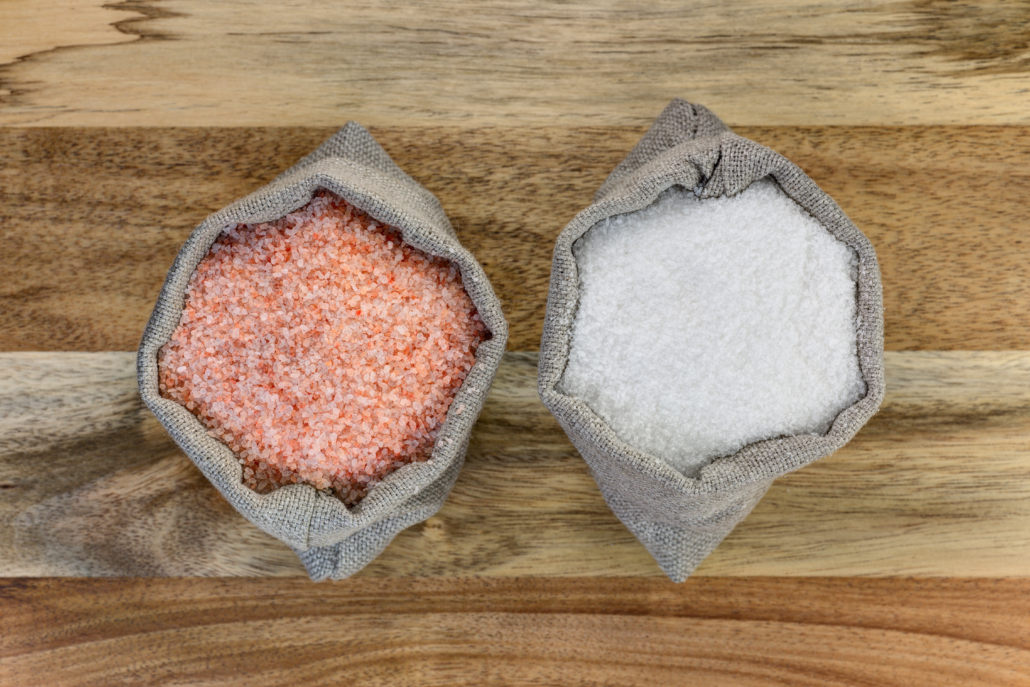We include products in articles we think are useful for our readers. If you buy products or services through links on our website, we may earn a small commission.
Himalayan Salt vs. Sea Salt: Based on Mineral Content and Purity

In the modern world, salt is seemingly abundant, with many novel types of salt to choose between, including pink Himalayan salt vs. sea salt.
Yet salt is more than a trendy flavor enhancer. Salt keeps us healthy. Your body needs the essential minerals in salt to maintain critical physiological functions such as nerve impulses, fluid balance, and muscle contractions. In fact, most people cannot survive without consuming salt for more than a few days!
It’s no surprise then that salt has been a coveted and often scarce commodity for millennia, with salt extraction being one of the oldest “chemical” industries. The Roman Empire even paid their soldiers with salt.
So, while Himalayan and sea salt may seem like mere seasonings, they have distinct nutritional profiles that set them apart.
In this article, we’ll embark on a comparative journey, pitting Himalayan salt against Celtic sea salt, examining their origins, mineral content, and potential health benefits. We’ll also explore emerging research into the potential for the microplastics accumulating in our environment to find their way into our salts, and how plastic contamination may affect our health.
Table of Contents
What is Pink Himalayan Salt?

Khewra Salt Mine. North of Pind Dadan Khan, Jhelum District, Pakistan. It is the second largest in the world, famous for its production of pink salt and is a major tourist attraction.
Source: https://en.wikipedia.org/wiki/File:Khewra_Himalayan_Pink_Salt_Mine_interior_view.jpg
Himalayan salt is a type of unrefined rock salt that comes from the foothills of the Himalayas. The salt, which can be pink or black in color, is mostly mined at the Khewra Salt Mine in the northern Punjab region of Pakistan.
Himalayan salt was formed over 200 million years ago when dried ancient sea beds were submerged by lava eruptions.
This ancient sea was pre-human, and these ancient salt vaults have been covered by snow, ice, and rock. This would lead you to believe that they have been protected from essentially all natural and industrial pollutants and impurities. But as we’ll discuss below, unfortunately, this isn’t necessarily the case.
The first records of mining in this area in Pakistan began around 1200 AD. However, local legend traces the discovery to the army of Alexander the Great in 320 BC.
Himalayan salt is minimally processed and extracted by hand, making it a more natural product than table salt, which requires huge industrial processes, including pumping brine into evaporation vats.
The distinct pink coloration of Himalayan salt is derived from the abundance of trace minerals, specifically iron.
In northern India, Himalayan salt has been used in folk medicine traditions as an emergency gastrointestinal curative.
What is Sea Salt?
Sea salt is derived from evaporated seawater and can vary greatly in flavor, color, and nutrient content. Modern sea salt production comes mainly from the Mediterranean Sea but can also be harvested from the Dead Sea and Atlantic Ocean.
In the case of popular Celtic sea salt, it is harvested off the coast of Brittany in northwest France. There it is processed using methods that are hundreds of years old, including air and sun drying in clay ponds. Then, it is gathered by hand with wooden tools to preserve its living enzyme content.

Celtic sea salt beds
Source: Lovesalt.com
Similar to Himalayan salt, there is minimal processing involved in sea salt, allowing it to retain its trace mineral composition. However, the mineral content of sea salt is less predictable and may vary dramatically depending on the location of origin and processing methods.
Unlike sea salt, table salt is by far the most processed derivative and contains no trace minerals. Table salt is bleached and mixed with an aluminum anticaking agent.
Why We Need Salt
Salt is an essential nutrient for human physiological function. We need it to produce hydrochloric acid in our stomach, which is needed to digest protein, kill harmful pathogens, and assimilate minerals.
Additionally, our bodies use the sodium and chloride in salt to support adrenal and immune functions and to regulate the sodium-potassium balance in the body, which powers our muscles and allows us to mobilize energy.
Many health organizations recommend about 1-2 tsp of salt per day, depending on the individual, to maintain these functions.
While carnivore dieters, keto dieters, and people practicing intermittent fasting generally need to consume 2-5 times as much salt.
So, when considering Himalayan salt vs. sea salt, which should we choose to power these vital functions?
Both pink Himalayan salt and sea salt are mostly composed of sodium chloride and contain trace minerals such as potassium, calcium, and magnesium. However, much has been made about the presence of microplastics as key difference setting these salts apart.
While Himalayan salt is supposedly protected from environmental contaminants like plastic pollution due to the process of land mining, sea salt is exposed to the rise of ocean pollutants, including the ubiquity of plastic.
One study found that 90% of all sea salt tested contained microplastics.
But does this make them more contaminated than Himalayan salt? Let’s explore
Toxins and Microplastics in Himalayan Salt vs. Sea Salt
According to research, about 3 billion tons of plastics are manufactured every year. And about 8 million tons of plastic will eventually make their way into a marine environment.
Microplastics, or plastic particles that are smaller than 5 mm in diameter, make up about 92% of the 5.25 trillion plastic particles on the ocean surface. Microplastics take about 500 years to degrade and break down.
When microplastics get into our bodies, they can act as endocrine disruptors, affecting the hypothalamus, pituitary, thyroid, adrenal, and reproductive organs and creating an overarching threat to human health.
While smaller microplastics can harm secondary organs and tissues, larger microplastics harm the gut microbiome.
Our bodies respond to microplastics as harmful toxins, triggering a natural inflammatory response.
But with consistent exposure to microplastics, our inflammatory response doesn’t turn off, leading to chronic inflammatory conditions like cardiovascular disease, autoimmune disorders, cancer, type 2 diabetes, and Alzheimer’s.
Ingestion of these microplastics affects all levels of the food chain and can bioaccumulate as we consume other animals–especially seafood, causing microplastics to build up in our bodies over time.
Sea salts from nearly every region of the world contain some microplastics.
| Country of Origin | Number of Brands Tested | Particle Per Kilogram |
| Croatia, Mediterranean (Fine sea salt) | 5 | 13500–19800 |
| Chinese, Taipei | 4 | 0-1300 |
| China | 5 | 550-681 |
| Thailand | 2 | 80-600 |
| USA | 1 | 300 |
| Spain (fine) | 7 | 80-280 |
| Spain (coarse) | 2 | 60-65 |
| Mediterranean | 2 | 266 |
| Sicilian Sea | 1 | 220 |
| Brazil | 1 | 200 |
| Mexico | 1 | 173 |
| Italy (fine) | 6 | 22-594 |
| India | 8 | 56-103 |
| Turkey | 5 | 18-84 |
| Australia | 3 | 0-80 |
| Portugal | 3 | 0-10 |
| France | 6 | 0-2 |
| Japan | 1 | 0-1 |
| Malaysia | 1 | 0-1 |
Microplastics in Himalayan Salt?
Though it’s not surprising to find microplastics in sea salt, we were surprised to find that pink and black Himalayan salt are contaminated with microplastics, and at higher levels than many sea salts.
| Origin | Number of Brands Tested | Particles per kilogram |
| Himalayan Rock Salt (unspecified color) | 1 | 367 |
| Himalayan Pink Salt | 1 | 174 |
| Himalayan Black Salt | 1 | 157 |
Himalayan Salt vs. Sea Salt Mineral Composition
Though microplastics are a concern, they aren’t the only parameter to consider when assessing Himalayan salt vs. sea salt.
Research suggests that Himalayan salt may contain substantially higher nutrient levels than sea salt, including iron, copper, and zinc, while containing over 80 trace minerals compared to sea salt’s 34 trace minerals.
Below, we’ve included a side-by-side comparison of the minerals in one kilogram of each type of salt.
| Compounds | Himalayan Salt | Celtic Sea Salt |
| Sodium | 38.26% | 33.1% |
| Chloride | 59.09% | 54.4% |
| Potassium | .35% | 0.215% |
| Calcium | 0.405% | 0.161% |
| Magnesium | 0.016% | 0.481% |
| Iron | 38.9 ppm | < 9.86 ppm |
| Zinc | 2.38 ppm | < 1.97 ppm |
| Copper | 0.56 ppm | < 2.47 ppm |
Himalayan Salt vs Sea Salt: The Bottom Line
Humans depend on the electrolytes in salt to maintain numerous critical physiological functions in the body. Salt is an essential nutrient that helps balance bodily fluids, supports our adrenal glands, and facilitates our muscular function and nerve impulses.
While pink Himalayan salt and sea salt are both popular choices, there are a few critical differences to consider.
While sea salt comes from evaporated seawater and can vary in terms of mineral composition, Himalayan salt is derived from a single ancient sea bed. For this reason, its mineral content is more uniform, and it is generally higher in various trace minerals when compared to sea salt.
However, emerging research revealing the prevalence of microplastics in various sea and terrestrial salts suggests that it may be wise to ignore the pink Himalayan salt hype and choose low-toxin sea salts, especially Celtic sea salt from France and sea salts from Japan and Portugal.





















